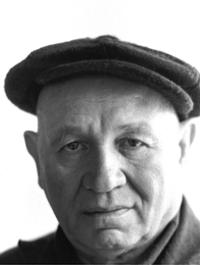
Romare Bearden (1911 - 1988)
Artist, Author and Songwriter

Photograph by Frank Stewart,
Romare Bearden Foundation
Romare Bearden was a multitalented artist, author and songwriter who drew from his personal experience to illustrate the broader experience of Black Americans, telling stories that connected the past to the 20th century. Delving into his personal experiences for insight, Bearden told stories through images that had a purpose. He merged his artistic expression with his cultural heritage to provide social commentary.
Born in Charlotte, North Carolina in 1911, Bearden and his family moved to Harlem, New York in 1920. Their household was a meeting place for many artists and writers of what has become known as the Harlem Renaissance. He completed his formal education in 1935, earning a degree in education from New York University. While working as a case worker for the New York City Department of Social Work, he continued to study art, including time at the Art Students League with artist George Grosz, and had his first solo exhibition in 1940. With assistance from the G.I. Bill, Bearden traveled to Paris in 1950, where he studied philosophy at the Sorbonne. While there he interacted with many European artists, such as Constantin Brancusi, Georges Braque, and Henri Matisse, and was influenced by modernist ideas of Cubist space and Fauvist color. Upon his return to the United States, Bearden continued his work in the visual arts along with songwriting and, in 1961, began a long-standing relationship with the Cordier & Ekstrom Gallery in New York City.
Bearden, along with artists Charles Alston, Norman Lewis, and Hale Woodruff, was a founding member of the Spiral Group. A Black artist’s collective active from 1963 to 1965 in New York City, the Group examined the relationship between art and social activism. The Group’s name referred to the Archimedean spiral which moves from a starting point outward in all directions while continuing to move forward. Bearden’s mature style developed over many years as he worked through modes of social realism, figuration, and abstraction. In the 1960s, he focused on his unique collage method, which combined historical and present-day imagery with a modernist concern for space and form. To create his collages, Bearden mixed together a variety of media: paint, colored paper, fabric, pencil, and magazine photographs. He often photocopied elements, such as faces and hands, and then manipulated and reassembled them. The collage work legitimized the use of common materials to fine art. His subject matter typically merged references of the rural American South and African ancestry (textiles and masks) with the cosmopolitan urban North. Using collage allowed Bearden to assemble, layer, and juxtapose contradictory images into a unified whole.
Bearden’s experimental and improvisational style can be seen in his printmaking work. In the late 1960s, he began a collaboration with the Printmaking Workshop, a nonprofit studio run by his longtime friend, the artist and master printer Robert Blackburn (1920-2003). Throughout his career, Bearden worked at the Workshop and with other printers to complete more than 100 prints using various techniques, often combining different printmaking methods and developing new processes to create images resembling his collages. Bearden’s imagery captured many aspects of Black America’s daily life. References to the Bible and religious traditions in lithographs such as Pilate and Three Women (Easter Sunday) emphasized the importance of spirituality within his community. In these prints, and many others, the way the figures are portrayed and the inclusion of areas resembling African textiles and patterns are reminiscent of his collage works.
Bearden also drew inspiration from classical literature. In the series titled the Odysseus Suite, he reinterpreted scenes from the journeys of the Greek poet Homer’s hero, using black figures and connecting the universality of the ancient Greek idea of finding one’s way home to 20th-century Black American life. The hero – whether a Greek warrior or a Black man – faced many challenges and struggles during his travels and triumphed over them all to discover his path home. Bearden equated the Black experience with the ancient tale to address the shared humanity of people from all backgrounds.
Romare Bearden was a prolific artist who experimented with different mediums and artistic approaches before focusing on his unique collage style. The collage technique allowed him to densely layer many references, creating overlapping meanings. His experiments in printmaking broke new ground, allowing him to recreate his imagery in multiples and make his work available to a wider audience.
Since the 1960s, his work has been exhibited at galleries and art institutions, nationally and internationally, culminating in a retrospective exhibition at the Museum of Modern Art, New York, in 1971. Two years after his death in 1988, the Romare Bearden Foundation was founded to "preserve and perpetuate" his legacy by "supporting educational programs, special projects, exhibitions, critical scholarship and seminal publications that deepen appreciation of and access to Bearden’s extraordinary art and life."
View selected works by Romare Bearden

